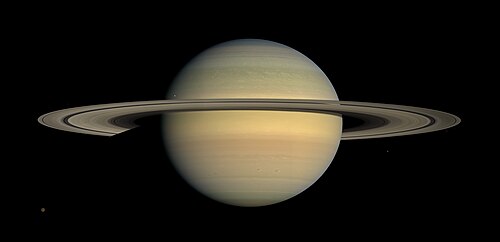Facts for Kids
Saturn is a gas giant known for its stunning rings and multitude of moons, making it one of the most intriguing planets in our Solar System.
Overview
Saturn's Rings
Moons Of Saturn
Exploration Missions
Cultural Significance
Atmosphere And Weather
Future Exploration Plans
Physical Characteristics
Comparison With Other Gas Giants

Inside this Article
Temperature
Spacecraft
Atmosphere
Enceladus
Hydrogen
Jupiter
Sickle
Planet
Earth
Did you know?
🌌 Saturn is the sixth planet from the Sun and the second-largest in the Solar System.
💍 Saturn is renowned for its stunning ring system, which is made up of ice and rock particles.
🌬️ The planet is mostly composed of hydrogen and helium, giving it a gaseous nature.
⏳ A day on Saturn is only about 10.7 hours long.
🌕 Saturn has at least 82 moons, with Titan being its largest and one of the few moons in the Solar System with a dense atmosphere.
🌀 The planet experiences extreme winds that can reach speeds of over 1,100 miles per hour.
🔆 Saturn has a very low density; if placed in water, it would float due to its gaseous composition.
🌈 Saturn's rings extend up to 175,000 miles from its equator but are very thin, sometimes just a few hundred feet thick.
🌌 The planet is visible to the naked eye from Earth, often appearing as a bright yellowish object in the night sky.
📸 In 2004, NASA's Cassini spacecraft began a fourteen-year mission studying Saturn and its moons.
Introduction
It’s famous for its beautiful rings made of ice and rock. Saturn is about 1.4 billion kilometers (870 million miles) away from the Sun! It takes Saturn about 29.5 Earth years to complete one orbit around the Sun, which means a year on Saturn is much longer than on Earth. Did you know that Saturn is a gas giant? This means it’s mostly made of gases, like hydrogen and helium, and doesn’t have a solid surface like Earth!
Saturn's Rings
They are made of billions of tiny ice and rock particles ranging in size from grains to giant boulders. The rings are about 280,000 kilometers (175,000 miles) wide but only about 10 to 100 meters thick! 🤯
Scientists believe these rings were formed from comets, moons, or asteroids that broke apart. There are several rings, named A, B, C, and more, with the A and B rings being the brightest. Isn’t it amazing that these rings are visible from Earth using a small telescope?
Moons Of Saturn
The largest moon is Titan, which is bigger than the planet Mercury! Titan has lakes of liquid methane and is covered with thick clouds. Another interesting moon is Enceladus, known for its icy geysers that shoot water vapor into space! Scientists think there could be an ocean beneath its icy crust! 🌊
Other notable moons include Rhea, Tethys, and Dione. Each moon has its unique features, and they are all fascinating to study!
Exploration Missions
Cassini took incredible pictures of Saturn and its rings, and it even discovered the geysers on Enceladus! Another mission was the Voyager 1 and 2 missions in the 1980s, which gave us our first close-up images of Saturn. These missions helped us learn so much about Saturn, its rings, and its moons. Isn’t it cool how scientists can explore other worlds?
Cultural Significance
In mythology, Saturn is often depicted with a sickle. Many cultures have also looked up to Saturn in the night sky. The planet can be seen with the naked eye and has been studied since ancient times. In astrology, Saturn is associated with discipline, responsibility, and hard work. People who believe in astrology say that Saturn influences our personalities and life lessons! Isn’t it interesting how a planet can have such an impact on our thoughts and stories?
Atmosphere And Weather
️ It has strong winds that can blow up to 1,800 kilometers per hour (about 1,100 miles per hour). The clouds are mostly made of hydrogen and helium, and you can find colorful bands of clouds with bright yellow, beige, and brown colors. One of the most famous storms is called the Great White Spot, which appears roughly every 30 Earth years and looks like a giant white cyclone! ❄
️ Saturn also has a temperature of around -178°C (-288°F), which is super cold! Brrr!
Future Exploration Plans
There are plans for new missions to study Saturn and its moons. One possible mission is called Dragonfly, which will send a drone-like spacecraft to Titan to fly around and study its surface and atmosphere in 2034. Another would like to look more closely at Enceladus to discover if it could support life! These exciting missions will help us learn more about Saturn and our solar system. 🚀
Who knows what amazing discoveries await us in the future?
Physical Characteristics
It has a diameter of about 120,536 kilometers (74,897 miles), making it nearly 9.5 times wider than Earth! What’s more interesting is that even with its size, Saturn is the least dense planet in our solar system; it could float in water if there was a bathtub big enough! 🌊
Its beautiful golden color comes from the clouds of gases in its atmosphere. Saturn’s rotation is very fast - it spins once on its axis in just about 10.7 hours! This makes the planet bulge a little at the equator, giving it an oblong shape.
Comparison With Other Gas Giants
Compared to Jupiter, Saturn is less massive, but still very large! Jupiter has 79 known moons, while Saturn has over 80. Uranus and Neptune have a different atmosphere, made mostly of methane, which gives them a blue color. 🌌
However, Saturn is unique because of its stunning rings that no other planet has! Each gas giant is special in its way, making our solar system a fascinating place to explore.

